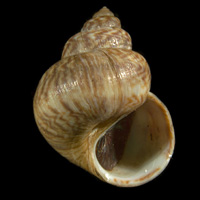|
< Previous family introduction |
|
|||||
 |
Family Amphibolidae Mangrove mud snails
|
|||||
|
The Amphibolidae is a family of air-breathing molluscs that lives in the upper littoral zone among mangroves, in salt marshes and on mud flats. Animals are abundant at some localities. Their primitiveness among air-breathing snails is testified by their possession of a horny operculum that completely seals the shell's aperture. The mantle cavity is well supplied with blood vessels and is used as a simple lung. They are hermaphroditic with separate male and female genital systems, and lay minute strings combining eggs, mud and mucus called a nidus that are sometimes visible on the surface of the mud. Up to 2007, only two species of this family were recognised in southern Australia - Salinator solida and S. fragilis. In 2007, Rosemary Golding, Winston Ponder and Maria Byrne found that the commoner species S. solida differed substantially from the type of the genus in organisation of the reproductive system, as well as in less fundamental characters of shell shape and colouration, radula dentition and operculum. The differences were considered to be sufficiently important to warrant the creation of the new family Phallomedusidae. Subsequent workers have not accepted this new family, but they have accepted the new genus Phallomedusa, and this course is followed here. The Amphibolidae occurs from south-east Asia to New Zealand, and presently contains 12 species. The largest and arguably best known of all is the New Zealand Amphibola crenata. In south-eastern Australia the species assigned to the family are Phallomedusa solida, Salinator fragilis, S. rhampidia and S. tecta, the latter two being described by Golding, Ponder and Byrne in 2007. Salinator fragilis is now considered to be restricted to southern Australia west of Port Phillip, Victoria, and it does not occur in NSW. Family Reference Golding, R.E., Ponder, W.F. & Byrne, M. 2007. Taxonomy and anatomy of Amphiboloidea (Gastropoda: Heterobranchia: Archaeopulmonata). Zootaxa 1476: 1-50. Coverage The three species of the family known from NSW are detailed here. Identification Notes Species of this family have small to large shells with rounded whorls, but are recognised as belonging here mainly because of their upper littoral habitat.
|